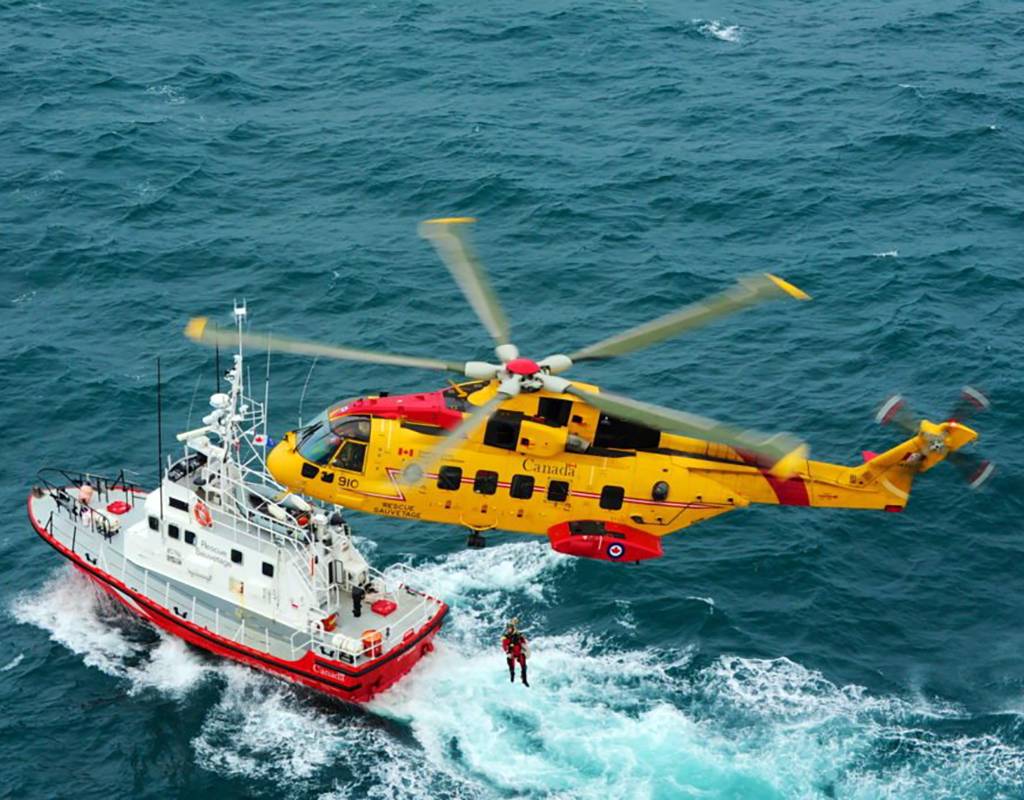
Negotiations between the Canadian government and Leonardo to extend the life of the CH-149 Cormorant search-and-rescue (SAR) helicopter fleet until 2040 have stalled, according to CBC.
Citing a briefing document to senior officials, the broadcaster said that a cost estimate provided by the Italian manufacturer to upgrade 14 aircraft to the same standard as the new Norwegian AW101-612 All-Weather Search-and-Rescue Helicopter (NAWSARH) and expand the fleet by two more greatly exceeded the project budget. As a result, “negotiations with the contractor were put on pause due to the proposals being unaffordable,” CBC quoted the document.
In a statement to media, the Department of National Defence confirmed that it had been working with Leonardo “to identify how these updates could be made” since first announcing a plan to upgrade the Royal Canadian Air Force (RCAF) variant of the AW101 to the Norwegian standard in April 2018.
“Extensive discussion and planning determined that upgrading the CH-149 fully to the Norwegian variant of the AW-101 was not a cost-effective solution to effectively meet the RCAF’s needs,” a DND spokesperson said in the statement. “After a year of consultation, it was determined that Leonardo couldn’t do the work at a cost that would respect the project’s overall budget.”
According to CBC, the briefing did not disclose Leonardo’s estimated cost. The project has a budget of around $1.03 billion.
Officials were told in the document that the Cormorant Midlife Upgrade (CMLU) project office and the RCAF are “investigating alternate solutions to address emerging obsolescence with [the] approved budget,” CBC reported.
“One option is a life-extension of the existing helicopters to meet regulatory requirements and upgrade obsolete parts. This would extend the life of the aircraft and leverage its existing capabilities,” DND confirmed in the media statement.
The department did not indicate whether the pause might mean reopening discussions with other manufacturers if it is unable to reach an agreement with Leonardo. Both Sikorsky, a subsidiary of Lockheed Martin, and Airbus had previously requested an open competition, arguing their search-and-rescue helicopters could provide the same service more effectively and efficiently. In interviews with Vertical in 2018, officials with both companies claimed improved availability rates and substantially lower operating costs — as much as 50 percent — over the Cormorant. Sikorsky planned to offer the S-92 in a SAR configuration while Airbus was proposing the H225, part of the Super Puma family.
The Cormorant entered service between 2001 and 2003 and has been plagued by parts obsolescence issues for several years. In the statement, DND acknowledged that “some of the on-board systems are already becoming obsolete and increasingly difficult to support, including engines.”
It also noted that the helicopter must upgrade its aircraft flight management, communications, navigation and safety systems to meet incoming traffic management and regulatory standards. “Intermediate steps are currently being taken within the in-service support program to ensure the helicopter is viable until an upgrade program can be put into place,” DND stated. “These measures include: borrowing parts between maintenance and operational aircraft, buying alternative parts, and increasing the maintenance requirements.”
Returning the Cormorant to Trenton
In April 2018, DND released a letter of notification (LoN) outlining its intent to conduct negotiations with Leonardo, formerly AgustaWestland, to replace, modify or upgrade current and projected obsolete systems on the CH149.
It justified the sole-source process at the time, citing the operational history of the platform in all Canadian SAR regions, often under extreme conditions, as well as the aircraft’s range and cabin capacity. The department also noted in the LoN that it had conducted a market survey with various manufacturers and an options analysis “which determined that the Cormorant is the only solution to meet the rotary-wing search-and-rescue capability requirements.”
As part of the NAWSARH-based upgrade, the RCAF configuration would include new cockpit displays, avionics, digital automatic flight control system, aircraft management system, electro-optical surveillance system, an obstacle proximity LiDAR system, weather radar, and new 3,000 horsepower CT7-8E engines.
The RCAF currently operates 14 Cormorants from three bases at 9 Wing Gander, Newfoundland, 14 Wing Greenwood, Nova Scotia, and 19 Wing Comox, British Columbia. In addition to upgrading the existing fleet, the project intended to add two more aircraft — a plan confirmed by the Minister of National Defence in August 2019. The extra airframes would allow the RCAF to return a Cormorant capability to 8 Wing Trenton, Ontario. The rotorcraft portion of SAR response in central Canada and over the Great Lakes is currently delivered by five yellow-painted CH-146 Griffons, which have less range and capacity.
How this will affect the search-and-rescue response from Trenton is unclear. DND said in the statement that replacing the CH-146 for SAR “is still a consideration while we are exploring other options to extend the Cormorant’s service life.”
The department also noted that modifications have been made to allow the Griffons to enhance their SAR operational capability. These include an increase in critical aircraft performance parameters to allow crews to remain in the hover for longer periods; faster hoist speeds; and a new life raft system and a low altitude warning system. In 2012, the Griffons received new avionics for better long range communication capabilities and the bubble windows were “repositioned to maximize the spotters’ effectiveness.”
DND is now fielding media queries about why cost estimates were not firmer before it announced negotiations with Leonardo in 2018. The department said it had developed “indicative cost estimates for the Norway variant” with Leonardo and partner companies in Team Cormorant during the options analysis phase of the procurement. “After more in-depth work in the definition phase, including refined costing based on a detailed statement of work and performance specification, it was determined that the solution proposed by Leonardo is more expensive than previously thought and outside the project budget.”
According to CBC, the briefing document suggested that the “project will need additional funds should the definition phase extend past June 2022, which is possible given the need to investigate alternate solutions.”



